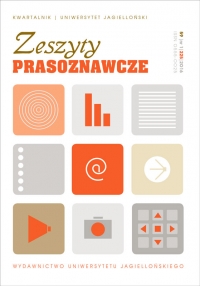Społeczne postrzeganie statusu zawodowego dziennikarzy przed i po 1989 roku. Analizy porównawcze
Public Perception of the Professional Status of Journalists Before and After 1989. Comparative Analyzes
Author(s): Małgorzata GruchołaSubject(s): Media studies, Recent History (1900 till today), Politics and communication, Theory of Communication
Published by: Wydawnictwo Uniwersytetu Jagiellońskiego
Keywords: public opinion; journalists; comparative analysis;
Summary/Abstract: Changes which began in Poland after 1989, radically changed the situation of the media. Media, which previously served as a service to authority regained independence, themselves becoming the “fourth power”. Action in terms of freedom of expression on the one hand gave various social groups the opportunity to articulate their arguments, on the other hand imposed on journalists a special responsibility. The aim of this paper is a comparative analysis of public perception of the professional status of journalists before and after 1989, in the light of public opinion polls conducted by the Center for Public Opinion Research and Public Opinion Research Centre in the years 1985– 2014. It is an attempt to answer the following research problems: – Is a journalist is seen just as many, or as a specific profession? – Is Journalism is a form of social service or business? – What is a group portrait of the journalist works in the public consciousness? In the process of research we assumed the following thesis: In the last 30 years the public perception of the status of professional journalist has not changed. However, we refuted the thesis which we formulated in the beginning of the article. In the last 30 years some unfavorable changes have occurred in the perception of the work of journalists. Has increased the belief that they seek sensationalism by all means and do not strive to reveal the truth. Their honesty and credibility weakened. More often they are perceived as biased. In developing the research material we used the following methodology: comparative analysis, secondary quantitative content analysis, qualitative content analysis and analytical and descriptive method.
Journal: Zeszyty Prasoznawcze
- Issue Year: 2016
- Issue No: 2 (226)
- Page Range: 348 - 368
- Page Count: 21
- Language: Polish

